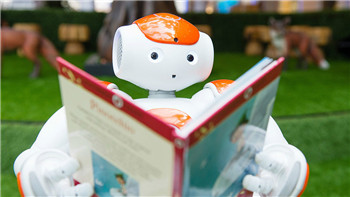(单词翻译:单击)

Rapid advances in artificial intelligence are feared by many in Europe and the US, with scientists warning of mass unemployment. But in Singapore, where restrictions on foreign workers have left many companies struggling for staff, service sector businesses are increasingly finding automated solutions to their workforce crunch.
人工智能领域的快速进步让欧美的许多人感到担忧,科学家们警告称,这可能导致大规模失业。但在新加坡,服务行业的企业越来越发现机器人可以解决它们人手紧张的问题——新加坡限制外国工人就业让许多公司很难招到员工。
From restaurants to hospitals, robots are being rolled out in a government-backed push to help businesses survive a tight labour market.
在政府为帮助企业在供应紧张的劳动力市场存活下去而推出的举措下,从饭店到医院,多种机构均出现了机器人的身影。
Louis Tan, chief operating officer of Singapore’s Mount Elizabeth Novena hospital, said: “The government is clamping down on foreign workers — there is difficulty in hiring even skilled workers. Technology has turned out to be one of the solutions.”
新加坡伊丽莎白诺维娜医院(Mount Elizabeth Novena)首席运营官Louis Tan表示:“新加坡政府正在限制外国工人——哪怕雇佣熟练工人也很困难。事实证明,技术是解决方案之一。”
The hospital, a private medical facility run by the Parkway Pantai group, has turned to IBM’s Watson technology as an automated “nurse” to monitor patients’ vital signs in its intensive care unit.
这家医院借助IBM的“沃森”(Watson)技术推出了机器人“护士”来监护重症病房中的病人的关键体征。伊丽莎白诺维娜医院是百汇班台集团(Parkway Pantai)运营的私立医疗服务机构。
The AI technology combines information from indicators such as blood pressure and heart rate, and uses a predictive algorithm to calculate the risk of a patient’s condition getting worse.
人工智能技术结合血压、心率等指标信息,并使用预测性算法来计算患者病情恶化的风险。
“In the past that required human integration and interpretation,” Mr Tan said. “And now we are using data analytics to help drive this.”
Louis Tan表示:“在过去,这需要人类加以整合和解读。现在我们使用数据分析学来帮助解读。”
The pilot, which was launched this year, has improved patient safety, Mr Tan added.
他补充称,今年推出的试点项目让病人更加安全。
He said: “It doesn’t mean nurses are absolved of responsibility. It just means they have another aid. It’s more efficient and safer for the patients.”
他说:“这并不意味着护士无事可干了。它仅仅意味着她们又有了一个助手,提高了她们照顾病患的效率和安全性。”
At Chilli Padi Nonya café, a restaurant serving a hybrid Malay-Chinese cuisine near the National University of Singapore, dirty dishes are gathered by a robotic waiter that trundles between tables chirping: “Could you help me to clear your table?”
在辣椒香娘惹餐厅(Chilli Padi Nonya),穿梭于桌子间的机器人侍者收拾着脏碟子,还能用清脆的声音问道:“你能帮我收拾下桌子吗?”该餐馆位于新加坡国立大学(National University of Singapore)附近,提供马来菜和中国菜。
The machine lacks the ability to pick up cups and plates itself. Instead customers place their used crockery in a tray it carries back to the kitchen.
这种机器人无法自己拿起杯子和碟子。顾客们将他们用过的餐具放到托盘上,然后由机器人拿回厨房。
Kannan Thangaraj, the restaurant’s manager, said: “In Singapore it’s very difficult to get manpower from overseas, so it’s very helpful to get a robot. The customers are coming back because of the robot. They like to see it.”
餐厅经理卡纳安•坦加拉贾(Kannan Thangaraj)表示:“在新加坡,从海外招募人手非常困难,因此使用机器人非常有帮助。顾客们因为机器人而成为回头客。他们喜欢看到机器人。”
So far, only a handful of restaurants are involved in trial usage of the robots. One deterrent is cost: the company which makes the machines, Singapore-based Unitech Mechatronics, sells them for S$47,000 (US$34,340).
迄今为止,只有少数几家餐馆在试用机器人。成本是一个障碍:总部位于新加坡的机器人制造公司Unitech Mechatronics对机器人的定价在4.7万新元(合3.434万美元)。
The government provides a subsidy of nearly 70 per cent of the robot’s cost for the restaurant trial, the company said.
该公司表示,新加坡政府为试用机器人的餐馆提供近70%的成本补贴。
Also in Singapore, a research and development centre for MasterCard has designed the first payment application for SoftBank Robotics’ humanoid robot Pepper.
同样在新加坡,万事达(MasterCard)的一家研发中心为软银机器人(SoftBank Robotics)的仿人机器人Pepper设计了首个支付应用。
Outlets of Pizza Hut in Asia will use the robot to take some customer orders and process card payments in a trial expected to take place this year. The goal is to free waiters for more complex interactions with customers.
亚洲的必胜客(Pizza Hut)门店将有望在今年试用Pepper接受一些顾客的订单并处理银行卡支付。目标是让侍者解放出来,处理与顾客的更为复杂的互动。
In this year’s budget, Singapore’s government announced plans to spend more than S$450m over the next three years to back the deployment of robots, with a focus on providing affordable robotics to small and medium-sized enterprises.
新加坡在今年的预算中宣布,计划在今后3年斥资逾4.5亿新元支持企业配备机器人,重点是向中小企业提供它们负担得起的机器人。
But the push to innovate has not been universally welcomed; in one Singapore restaurant piloting a robot dish-collector, the machine was smashed to pieces by a member of staff.
但这种创新举措并未普遍受到欢迎;在新加坡一家试用机器人收拾盘子的餐馆里,一位员工将机器人打得粉身碎骨。
While there has been a global boom in the use of industrial robots, with 248,000 units sold in 2015 according to research by the International Federation of Robotics, sales of service sector robots have lagged behind.
尽管全球范围内已经在大量使用工业机器人——国际机器人联合会(International Federation of Robotics)的调查显示,2015年工业机器人销量为24.8万台——但服务业机器人的销量要少得多。
Sales of service robots rose to about 24,000 units in 2014 compared with just under 22,000 the year before.
2014年,服务业机器人的销量升至约2.4万台,而2013年还不到2.2万台。
Analysts predict that the worldwide market for service industry robots is poised to take off, as technical advances allow robots to perform more complex tasks and work in more unpredictable environments.
分析师预计,随着科技进步使得机器人能够执行更加复杂的任务并在更加不可预测的环境中工作,全球范围内服务行业机器人的销量将会飙升。
In Japan, where robots are widely used in manufacturing, the government has launched a push to increase their use in services including healthcare and nursing homes.
在制造业广泛使用机器人的日本,政府出台措施,推动包括医疗保健和居家护理在内的服务行业增加机器人的使用。


